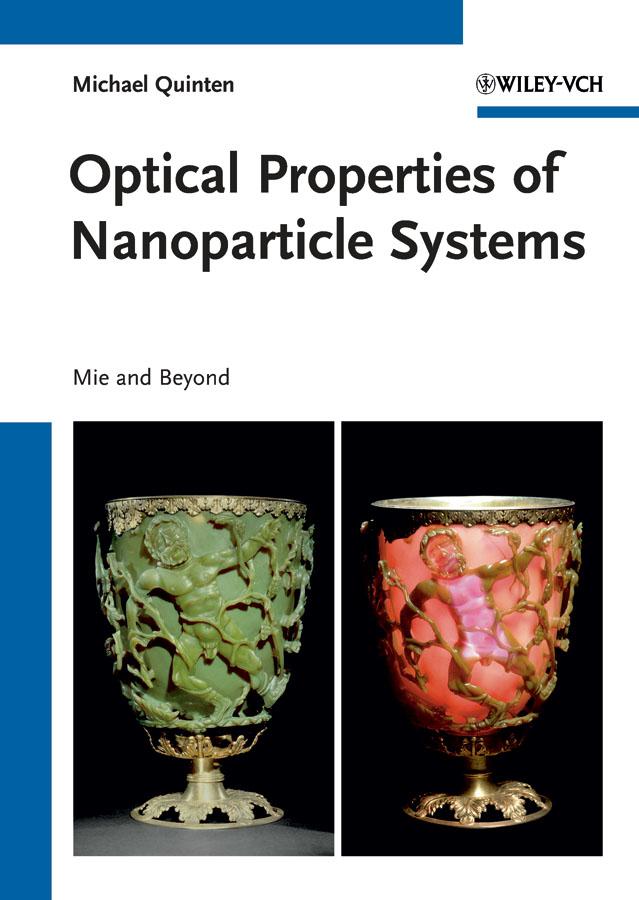
INDICE: 1 Introduction. 2 Nanoparticle Systems and Experimental Optical Observables. 2.1 Classifi cation of Nanoparticle Systems. 2.2 Stability of Nanoparticle Systems. 2.3 Extinction, Optical Density, and Scattering. 3 Interactionof Light with Matter The Optical Material Function. 3.1 Classical Description. 3.2 Quantum Mechanical Concepts. 3.3 TaucLorentz and OJL Models. 3.4 KramersKronig Relations and Penetration Depth. 4 Fundamentals of Light Scattering by an Obstacle. 4.1 Maxwells Equations and the Helmholtz Equation. 4.2 Electromagnetic Fields. 4.3 Boundary Conditions. 4.4 Poyntings Law and Cross-sections. 4.5 Far-Field and Near-Field. 4.6 The Incident Electromagnetic Wave. 4.7 Rayleighs Approximation for Small Particles The Dipole Approximation. 4.8 RayleighDebyeGans Approximation for Vanishing Optical Contrast. 5 Mies Theory for SingleSpherical Particles. 5.1 Electromagnetic Fields and Boundary Conditions. 5.2 Cross-sections, Scattering Intensities, and Related Quantities. 5.3 Resonances. 5.4 Optical Contrast. 5.5 Near-Field. 6 Application of Mies Theory. 6.1 Drude Metal Particles (Al, Na, K). 6.2 Noble Metal Particles (Cu, Ag, Au). 6.3 Catalyst Metal Particles (Pt, Pd, Rh). 6.4 Magnetic Metal Particles (Fe, Ni, Co).6.5 Rare Earth Metal Particles (Sc, Y, Er). 6.6 Transition Metal Particles (V, Nb, Ta). 6.7 Summary of Metal Particles. 6.8 Semimetal Particles (TiN, ZrN).6.9 Semiconductor Particles (Si, SiC, CdTe, ZnSe). 6.10 Carbonaceous Particles. 6.11 Absorbing Oxide Particles (Fe2O3, Cr2O3, Cu2O, CuO). 6.12 Transparent Oxide Particles (SiO2, Al2O3, CeO2, TiO2). 6.13 Particles with Phonon Polaritons (MgO, NaCl, CaF2). 6.14 Miscellaneous Nanoparticles (ITO, LaB6, EuS). 7 Extensions of Mies Theory. 7.1 Coated Spheres. 7.2 Supported Nanoparticles. 7.3 Charged Nanoparticles. 7.4 Anisotropic Materials. 7.5 Absorbing Embedding Media. 7.6 Inhomogeneous Incident Waves. 8 Limitations of Mies Theory Size and Quantum Size Effects in Very Small Nanoparticles. 8.1 Boundary Conditions the Spill-Out Effect. 8.2 Free Path Effect in Nanoparticles. 8.3 Chemical Interface Damping Dynamic Charge Transfer. 9 Beyond Mies Theory I Nonspherical Particles. 9.1 Spheroids and Ellipsoids. 9.2 Cylinders. 9.3 Cubic Particles. 9.4 Numerical Methods. 9.5 Application of Numerical Methods to Nonspherical Nanoparticles.10 Beyond Mies Theory II The Generalized Mie Theory. 10.1 Derivation of the Generalized Mie Theory. 10.2 Resonances. 10.3 Common Results. 10.4 Extensions of the Generalized Mie Theory. 11 The Generalized Mie Theory Applied to Different Systems. 11.1 Metal Particles. 11.2 Semimetal and Semiconductor Particles. 11.3 Nonabsorbing Dielectrics. 11.4 Carbonaceous Particles. 11.5 Particles with Phonon Polaritons. 11.6 Miscellaneous Particles. 11.7 Aggregates of Nanoparticles of Different Materials. 11.8 Optical Particle Sizi
- ISBN: 978-3-527-41043-9
- Editorial: Wiley-VCH
- Encuadernacion: Cartoné
- Páginas: 502
- Fecha Publicación: 26/01/2011
- Nº Volúmenes: 1
- Idioma: Inglés
